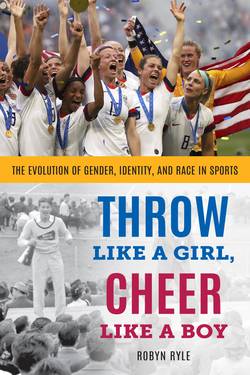Читать книгу Throw Like a Girl, Cheer Like a Boy - Robyn Ryle - Страница 10
На сайте Литреса книга снята с продажи.
World War II and the Big Switch
ОглавлениеDuring the time period when all cheerleaders were male, most women were playing their own sports, even if many of them weren’t allowed to get too competitive. At the same time, there were concerns that if girls started cheerleading, they would become manly and conceited. So what changed? The simple answer is that World War II brought about a rapid transformation in cheerleading. As it did for many areas of social life, World War II altered the relationship between gender and sports, and this wasn’t only because women flooded into cheerleading to take the place of men fighting overseas, though this did happen in some places.
During the war, colleges scaled back on all extracurricular activities that weren’t seen as essential, which included sports programs for women. A 1943 survey found that most colleges had either eliminated or reduced their women’s sports programs. As a result, some women became cheerleaders to fill the gap left by men fighting overseas.[13] But women were also looking for a physical activity to take the place of their disappearing sports programs.[14] Cheerleading became a convenient way for women accustomed to being physically active to maintain that lifestyle.
With increasing numbers of women leading the cheers from the sidelines, the meaning of cheerleading changed. Cheerleading couldn’t be considered an inherently masculine activity anymore if it was being done mostly by women. It also wouldn’t be seen as a first step in a successful and ambitious career beyond college, as it had been for men. Cheerleading became viewed as a much less important activity when women filled its ranks. When women led cheers, it wasn’t a reflection of their leadership skills and athleticism. In fact, much of the athleticism that had been associated with cheerleading disappeared. Instead, cheerleading was increasingly sexualized. Descriptions of cheerleaders emphasized their appearance and attractiveness rather than their voice or ability to perform stunts. Cheerleaders were pretty and sexy, not future leaders and captains of industry.[15]
Outside the sporting world, the gender switch in cheerleading mirrors what happened in many occupational fields. The occupation we now call “secretary” used to be done by “clerks,” who were all men. Clerks were certainly not expected to be cheerful and attractive, like proxy wives in an office setting. But when women began doing the same tasks clerks had once done, the job of secretary emphasized these feminine qualities. When most teachers in the United States were men, their authority and knowledge were seen as important qualities of the job. As women took over, nurturing and compassion became important characteristics for teaching.
It only took a couple of decades for cheerleading to completely switch into an activity seen as overwhelmingly and inarguably feminine. By the 1950s, cheerleading was no longer a prestigious, masculine domain. For a young woman, becoming a cheerleader was a surefire way to demonstrate the ideal form of femininity—pretty, nonathletic, and largely an accessory to men’s activities.
